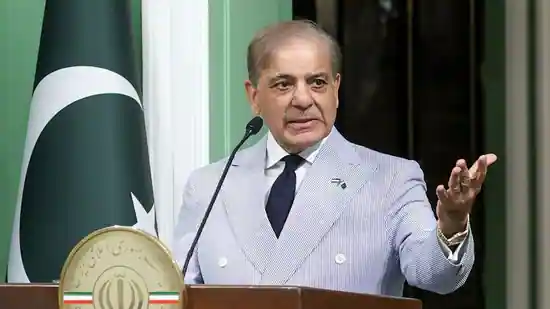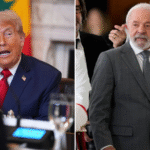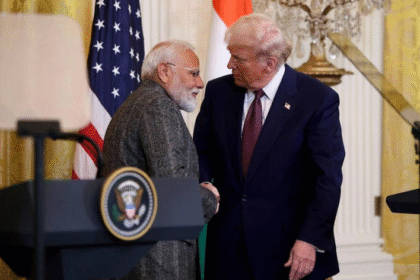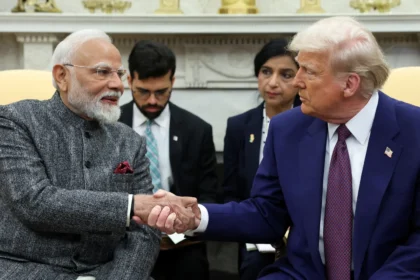PM Shehbaz Sharif Hails Landmark Pakistan-US Trade Agreement as Boost for Bilateral Ties
The recent landmark trade agreement between Pakistan and the United States has generated significant attention across geopolitical and economic circles. Prime Minister Shehbaz Sharif’s official statement hailing the deal as a “milestone” in bilateral relations reflects the growing momentum in Pakistan’s foreign policy realignment and economic diversification strategy. This agreement, considered one of the most comprehensive trade pacts in recent years for Pakistan, signals a renewed push toward global economic integration and strategic alignment.
For years, trade relations between the two countries had plateaued, largely overshadowed by security-related cooperation and diplomatic turbulence. However, with shifting global dynamics—especially in a post-pandemic world where supply chain resilience and market diversification are paramount—both Islamabad and Washington appear committed to resetting the tone of their economic partnership. The newly inked deal is not merely a transactional accord but a policy statement. It serves as a declaration of intent to build a sustainable, multifaceted relationship that moves beyond the traditional lens of aid, military assistance, and counterterrorism.
From textile exports and information technology services to green energy collaboration and agricultural innovations, the new agreement opens doors across various sectors. But more importantly, it comes at a time when Pakistan is navigating a precarious economic situation marked by external debt obligations, inflationary pressures, and a depreciating currency. The U.S., by agreeing to deeper economic ties, may be signaling an intent to serve as a stabilizing force while simultaneously asserting its strategic influence in South Asia—particularly at a time when China’s economic and infrastructural footprint in Pakistan continues to expand through the China-Pakistan Economic Corridor (CPEC).
This article begins a multi-part, in-depth analysis of the trade agreement, its implications, its background, and the broad horizon of opportunities and challenges that lie ahead. Each part will delve into specific domains, ranging from sectoral impacts and political narratives to global reactions and long-term forecasts. Through this expansive study, we aim to understand how a single agreement may become the cornerstone of a new chapter in Pakistan-US relations.
Key Features of the Pakistan-US Trade Agreement
The trade agreement signed between Pakistan and the United States represents a strategic shift in bilateral economic policy. Unlike earlier engagements that focused heavily on military cooperation or sporadic aid packages, this deal sets a concrete framework for sustained trade growth rooted in mutual economic interest. Here are the most notable features of the agreement:
- Tariff Reductions and Market Access: One of the cornerstone features of the agreement is the reduction in tariffs on a variety of goods exported from Pakistan to the U.S. These include textiles, surgical instruments, leather goods, and sporting equipment. In return, Pakistan has agreed to ease import duties on American agricultural technology, pharmaceutical products, and renewable energy infrastructure.
- Technology and Services Exchange: The agreement includes a chapter dedicated to the facilitation of IT and digital services, ensuring American tech companies can operate in Pakistan with minimal regulatory hurdles. Pakistani tech startups and software service providers will also gain access to U.S. markets through a special provision for digital services cooperation.
- Intellectual Property Protection: For the first time, Pakistan has agreed to align more closely with international standards of intellectual property rights enforcement. This has been a longstanding concern for U.S. businesses, and its inclusion in the agreement is seen as a trust-building move that will encourage innovation and investment.
- Labor and Environmental Standards: A progressive element of the trade deal is the mutual commitment to upholding labor rights and environmental protections. Pakistan has agreed to adopt international labor standards and commit to phasing out environmentally harmful practices in its industrial sectors.
- Dispute Resolution Mechanism: The agreement establishes a fast-track, neutral arbitration mechanism to resolve trade-related disputes. This will be crucial in maintaining investor confidence and preventing small-scale trade issues from escalating into larger diplomatic standoffs.
- Energy and Infrastructure Collaboration: The agreement opens the door for joint ventures in green energy—especially solar and wind—as well as U.S. participation in Pakistan’s infrastructure modernization. This includes smart grids, urban mobility systems, and logistics hubs.
These key features form the structural foundation of the agreement and signal the seriousness with which both countries are approaching this renewed chapter. As we proceed in the next section, we will look at how each of these components has been received within various domestic sectors in Pakistan, from industry leaders to trade unions and environmental advocates.
Domestic Reactions in Pakistan – Optimism, Caution, and Sectoral Response
The announcement of the Pakistan-US trade agreement has stirred a spectrum of responses within Pakistan, ranging from enthusiastic endorsements by the business community to more cautious appraisals from political and civil society groups. The accord’s multidimensional scope has implications for nearly every major economic sector, and its reception offers valuable insight into the internal dynamics that could influence its implementation.
1. Business and Industry Leaders Welcome Economic Opportunity
Across Pakistan’s industrial corridors—from Sialkot’s surgical manufacturing units to Faisalabad’s textile hubs—business leaders have largely embraced the agreement. Textile exporters, in particular, see the tariff concessions as a significant breakthrough, predicting a surge in demand from U.S. retailers due to increased price competitiveness. According to the Pakistan Textile Exporters Association (PTEA), the reduction in duties could boost textile exports by at least 20% over the next fiscal year.
Chambers of commerce in Karachi and Lahore have issued joint statements lauding the agreement as a “transformational step” for Pakistan’s export-oriented industries. They argue that expanded market access and simplified dispute mechanisms are precisely what Pakistani businesses need in the face of growing global competition and domestic economic uncertainty.
2. Tech Entrepreneurs and Startups Eye Access to U.S. Markets
Pakistan’s nascent but rapidly growing tech ecosystem has also responded with cautious optimism. Founders of local fintechs, SaaS startups, and e-commerce platforms see the digital services provision as a game-changer. The MoU’s clauses around minimal regulatory friction for tech collaboration could lead to increased investments, joint ventures, and possibly inclusion in global tech supply chains.
The Pakistan Software Houses Association (P@SHA) has welcomed the move, urging the government to follow through with digital infrastructure upgrades and capacity building to fully capitalize on U.S. market access.
3. Agricultural Sector Divided Over Import Concessions
While export-oriented agribusinesses are hopeful that enhanced U.S. engagement will mean better access to modern farming technology, small and medium-sized farmers have expressed concern over increased imports. Farmer unions, particularly in Sindh and Punjab, worry that the influx of subsidized American agricultural goods could undercut local producers.
To address this, the Ministry of Commerce has promised to implement safeguard clauses that ensure essential protections for domestic farmers. However, clarity on how these will function in practice is still lacking.
4. Labor Unions Voice Conditional Support
Labor unions have responded positively to the inclusion of international labor standards in the agreement but have warned that enforcement will be key. The All Pakistan Trade Union Federation (APTUF) has called for immediate reforms in factory-level working conditions and for a transparent monitoring body to ensure compliance.
They argue that Pakistan’s history of lax enforcement—especially in the textile and manufacturing sectors—could undermine the spirit of this provision unless backed by political will and administrative reforms.
5. Environmental Advocates Welcome Green Commitments
Environmental groups, including the Pakistan Environmental Protection Network and the Sustainable Development Coalition, have welcomed the agreement’s commitment to phasing out environmentally damaging industrial practices. They particularly endorse the focus on renewable energy collaboration and have proposed that joint oversight bodies be created to monitor ecological impacts of industrial expansion under the deal.
However, some experts have also pointed out that Pakistan has a mixed record on environmental compliance and warn that unless robust systems are established, the green promises could remain symbolic.
6. Political Landscape – Cautious Optimism with Strategic Undertones
Within political circles, the governing Pakistan Muslim League-Nawaz (PML-N) has celebrated the deal as evidence of Prime Minister Shehbaz Sharif’s diplomatic acumen and economic foresight. On the other hand, opposition parties, particularly Pakistan Tehreek-e-Insaf (PTI), have taken a more skeptical view, questioning the long-term strategic consequences of deeper U.S. involvement.
They argue that while economic benefits are undeniable, Pakistan must carefully balance its foreign relations—especially with China, whose economic influence remains deeply embedded in the country’s infrastructure through CPEC.
The U.S. Perspective – Strategic Depth, Economic Outreach, and Political Reception
While the Pakistan-US trade agreement marks a landmark shift for Islamabad, it also signals a deliberate recalibration in Washington’s South Asia strategy. In recent years, U.S. foreign economic policy has increasingly emphasized diversified partnerships, supply chain resilience, and strategic balancing amid China’s growing global influence. From this vantage point, the agreement with Pakistan is not merely an economic gesture but a layered move with far-reaching diplomatic, commercial, and geopolitical implications.
1. Washington’s Strategic Intent: A Soft Power Realignment
The Biden administration, and more broadly the U.S. foreign policy establishment, has signaled a pivot toward leveraging economic diplomacy to reshape alliances. The trade agreement with Pakistan fits squarely into this matrix. As U.S. policymakers continue to emphasize a free and open Indo-Pacific, re-engaging Pakistan economically serves as a hedge against Beijing’s dominance in the region.
By granting Pakistan expanded market access and promising joint ventures in energy, technology, and infrastructure, Washington positions itself as a counterweight to China’s Belt and Road Initiative (BRI)—particularly the China-Pakistan Economic Corridor (CPEC). Importantly, the deal allows the U.S. to retain influence in a region where its security footprint has diminished post-Afghanistan withdrawal.
2. Congressional and Bureaucratic Support
Initial reports suggest the trade agreement has received broad bipartisan support in Congress, particularly among lawmakers aligned with the House Foreign Affairs and Senate Finance Committees. Members have framed the accord as a pragmatic step toward enhancing regional stability and creating export opportunities for American businesses.
The Office of the United States Trade Representative (USTR), along with the Departments of Commerce and State, have jointly emphasized that the deal aligns with U.S. interests in sustainable economic partnerships, climate collaboration, and intellectual property enforcement. Trade officials have pointed to the Pakistani commitment to stronger IP laws as a breakthrough that could encourage American innovation abroad.
3. U.S. Industry Response: Keen Interest in Market Entry
Several U.S. industries have welcomed the agreement, particularly in sectors where market saturation or geopolitical restrictions elsewhere have made expansion challenging. Agricultural technology firms, pharmaceutical companies, and clean energy enterprises see Pakistan as a high-potential but previously underutilized destination.
The U.S. Chamber of Commerce and the National Foreign Trade Council (NFTC) have issued positive statements, noting that Pakistan’s large population, evolving urban centers, and improving digital infrastructure offer opportunities for scalable, long-term investment.
Moreover, Silicon Valley-based firms in cloud services, cybersecurity, and e-commerce logistics have taken a special interest in the digital services chapter of the agreement. Industry analysts believe this could pave the way for collaborative pilot projects, tech incubators, and even satellite offices in major Pakistani cities.
4. Concerns and Caution within U.S. Policy Circles
Despite the optimism, certain cautionary notes have emerged within U.S. policy and media circles. Think tanks like the Center for Strategic and International Studies (CSIS) and the Carnegie Endowment for International Peace have urged vigilance over Pakistan’s implementation record. Key concerns include:
- Regulatory consistency: U.S. investors want assurance that Pakistan’s regulatory environment will remain stable and predictable over time.
- Security landscape: While trade is the focus, residual instability in parts of Pakistan continues to shape American risk assessments.
- China overlap: Some in Washington are wary of duplicating or competing with Chinese projects already underway through CPEC, raising questions about economic redundancy or geopolitical friction.
Nevertheless, most assessments agree that the strategic benefits outweigh the risks—particularly if the agreement helps draw Pakistan further into the orbit of U.S.-led global economic frameworks.
5. Diplomatic Reception and Global Signaling
The agreement has also been interpreted as a broader signal to South Asian and Middle Eastern allies that the U.S. is not retreating from economic engagement. Following India’s close alignment with the U.S. through the Quad, and recent tech-focused trade pacts with Vietnam and the Philippines, this deal with Pakistan rounds out Washington’s footprint in South Asia.
American diplomats have characterized it as a “reset button” in U.S.-Pakistan ties, moving away from the episodic, security-centric engagement of the past two decades toward a more consistent, economy-first relationship. This has been welcomed by several U.S. allies in the Gulf and Europe, who view Pakistan as a key node in both regional logistics and energy transit systems.
The signing of the landmark Pakistan–US trade agreement has inevitably rekindled strategic discussions around Pakistan’s positioning within the global power matrix—especially between two giants: the United States and China. As the ink dries on the deal, the question dominating diplomatic and analytical circles is this: Can Pakistan successfully balance its deep-rooted economic and infrastructural ties with Beijing while pursuing expanded economic engagement with Washington?
This is not a theoretical dilemma—it’s a live, complex geopolitical balancing act, one with ramifications not only for Pakistan’s foreign policy but also for the wider Indo-Pacific region and beyond.
Pakistan’s Dual-Track Foreign Policy Doctrine
Historically, Pakistan has practiced what foreign policy scholars refer to as “strategic duality.” It has managed alliances that often appear ideologically or strategically incompatible—maintaining defense cooperation with the U.S. during the Cold War and post-9/11 era, while simultaneously deepening economic interdependence with China.
In the 21st century, especially after CPEC was launched in 2015, China emerged as Pakistan’s most vital economic partner, funding over $60 billion in projects from highways and ports to power plants and digital infrastructure. However, Pakistan’s leadership never severed ties with the U.S., aware of the geopolitical leverage and technological access Washington still offers.
This duality is now being tested more than ever, as Washington positions this new trade agreement as part of a broader counter-China economic strategy.
2. China’s Calculated Silence and Subtle Messaging
In the wake of the trade deal’s announcement, China’s official reaction has been notably restrained. The Chinese Foreign Ministry simply stated that “Beijing respects all bilateral decisions made by Pakistan in the spirit of mutual benefit.” However, behind closed doors, diplomatic analysts believe Beijing is watching closely for any signs of strategic realignment.
Several key concerns dominate the Chinese view:
- CPEC vs. U.S. Investment: If American infrastructure funding or tech partnerships begin to overlap with CPEC domains—such as telecommunications, energy grids, or port logistics—China may perceive this as competitive encroachment.
- Data Sovereignty and Surveillance: U.S. tech firms entering Pakistan’s digital ecosystem might push for data localization and cybersecurity standards aligned with Western norms—directly challenging China’s existing digital infrastructure footprint in the country.
- Military and Strategic Proximity: While the current deal is civilian-focused, any secondary agreements or security collaborations arising from renewed economic ties could recalibrate the military balance in South Asia.
Despite these concerns, Chinese analysts remain confident that Pakistan will not abandon the China partnership. As one think tank in Beijing commented, “America is bringing trade. China already brought roads, power, and steel. Pakistan knows it needs both.”
3. Islamabad’s Balancing Rhetoric: Neutral, Pragmatic, Nationalist
Pakistani leadership—from Prime Minister Shehbaz Sharif to Foreign Minister Ishaq Dar—has repeatedly emphasized that the trade agreement with the U.S. is “not at the expense of any existing alliance.” Official statements stress:
- The agreement is “commercial, not confrontational.”
- Pakistan remains “committed to strategic cooperation with China” through CPEC.
- The country is now following a “multi-vector foreign policy” akin to Turkey or Indonesia.
Behind this language lies a tactical decision: rather than choose sides in the growing U.S.-China rivalry, Pakistan aims to leverage both for national development and regional influence. This approach mirrors other developing nations seeking infrastructure from China and markets or technology from the U.S.
4. Regional Implications: India, the Gulf, and Central Asia
India’s Perspective:
India, a key U.S. strategic ally, is monitoring this deal with a mixture of concern and calculation. While the U.S.–Pakistan trade pact is not military in nature, New Delhi views any normalization of Washington–Islamabad ties through a cautious lens. Strategists worry that economic revival in Pakistan—if U.S.-facilitated—could translate into more assertive regional posturing.
Gulf Nations:
Pakistan’s Gulf partners, particularly Saudi Arabia and the UAE, have welcomed the U.S. deal as a sign of economic stabilization in Pakistan. These nations, already deeply involved in Pakistan’s energy and construction sectors, view enhanced U.S. involvement as a risk mitigator.
Central Asia and the New Silk Road:
Pakistan’s geographic location gives it unique access to Central Asian markets, and this trade deal could transform it into a connector between U.S.-backed ventures and regional trade corridors. Already, Kazakhstan and Uzbekistan have expressed interest in trilateral agreements involving Pakistan and American firms.
5. The Risks of Overplaying the Middle Ground
While the dual engagement model sounds ideal, it is fraught with risk. The more Pakistan leans into American trade norms, transparency, and regulatory structures, the more pressure it may face from Chinese stakeholders who have historically preferred opacity and exclusivity in their projects.
Similarly, if Pakistan caves to Chinese pressure to restrict U.S. digital influence, it may lose out on valuable tech partnerships and export pathways. In short, navigating this middle ground will require unprecedented diplomatic agility, strategic foresight, and institutional coherence—qualities that Pakistan’s civil-military leadership will now be tested on in real time.
Also Read : President Lula’s Bold Defiance Pays Off: Trump Backs Down on Brazil Tariffs After 6-Month Standoff








